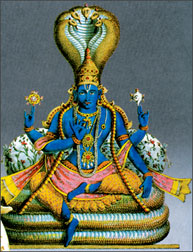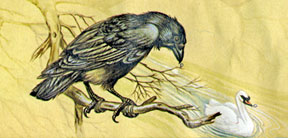|
Aunt Mali’s Children
The birth of Hinduism
|

God Vishnu
|
|

God Ganesh
|
Hinduism, one of the world’s oldest religions, began with the Aryan
invasion of India. One of Hinduism’s key ideas is the belief that all
living things are connected. And ancient Aryan text has this verse:
“As the rivers flowing east and west
Merge (join) in the sea and become one with it,
Forgetting they were ever separate rivers,
So do all creatures lose their separateness
When they merge at last into pure Being.”
* Ancient writings
Today, there are about 800 million Hindus. Like most religions,
Hinduism is practiced in many different ways. Yet all Hindus share some
basic beliefs. Hindus also share a history that stretches back to the
ancient past of the Indian subcontinent.
When Aryans first came to the Indian subcontinent around 1500 B.C.,
they had little in common with the Harappans. The two people had
different languages and cultures.
Harappans had built great cities like Mohenjo-Daro. Aryan people
lived in small villages, moving frequently to seek pastures for their
herds. Over time, the two groups began to learn from each other. Aryans
became farmers and craft workers like their Harappan neighbours.
The Harappans, in turn, learned ancient Aryan songs. At first, these
songs, believed to be sacred, were passed down by oral tradition.
Between 1000 and 300 B.C. the songs were written in books called the
Vedas (VAY duz), or “Books of Knowledge.”
* A culture of classes
These four classes of people developed into India’s complex caste
system. The caste system organizes all of India’s Hindus into hundreds
of groups and levels.
According to Hindu beliefs, each person is born into a caste, or
level, and this cannot be changed. People of the priestly caste have the
highest rank and respect. They must study and teach people about the
Vedas. People of the servant caste are thought to be born to serve
members of the other castes.
* The Vedas
The Vedas contain the basic beliefs of Hinduism. They offer an
explantation of life, and they tell Hindus how they should live. The
oldest Veda has more than 1,000 religious songs. It says that the world
is controlled by many gods and goddesses, like the goddess in the song
on this page.
* The Hindu way of life
This poem from the Vedas explains the Hindu belief about the correct
way to live. One belief is that four different types, or classes, of
people were created. The following poem explains that the first people
came from different parts of a god’s body.
The Priest was his mouth;
His arms became the Princes;
His (legs) produced the
Professionals and Merchants;
His feet gave birth to the Servant.
* The cycle of life
According to the Vedas, people move in a continuing circle of birth,
death and rebirth. This cycle is called reincarnation. Each
reincarnation is a punishment or a reward for the life one led before.
Hindus believe that rebirth is the only way to alter one’s caste.
Good deeds done in one’s life are rewarded by birth into a higher caste
in the next life.
According to this belief, people born as servants, then, are paying
for wrongs done in past lives. Members of the priest caste are being
rewarded for good deeds they had done in a previous life.
* Duty or disorder
How do Hindus in each caste know how to behave? The Vedas also
provide laws and duties, called dharma. The dharma includes hundreds of
rules that tell Hindus of each caste how to live.
For example, merchants are responsible for producing and selling
goods and services honestly. Priests have to spend some of their time
working to support their families. Part of the dharma of servant is to
serve others cheerfully and without complaint.
The vedas listed the jobs that could or could not be done by members
of each caste. The Vedas also warned against breaking the rules of
dharma, saying disorder would result. Following dharma kept Hindu
society running smoothly. One of the sacred writings said:
If a person is engaged in doing his proper work, he reaches the
highest end.
People who married against the rules of their caste, or who did a job
their caste was not permitted to do, were forced to live outside all
castes. These “outcastes” were looked down upon by others and said to be
“impure.” Some Hindu priests performed a “cleansing” ceremony if they
touched even the shadow of an outcaste. Since the children of outcastes
were also born outside the caste system, they too spent their lives as
“untouchables”. They usually lived in terrible poverty and were given
only the worst kinds of jobs.
* Many paths, one goal
Like other religions, Hinduism developed many different forms. Some
Hindus believed dharma called them to perform special exercises, or to
eat no meat, fish, or eggs. Other Hindus explored non-Hindu beliefs as
they tried to understand the meaning and laws of life.
These different ideas did not upset Hindu priests. Unlike some other
religions, Hinduism permits more than one god, and more than one way to
truth. In one well-known Hindu book, the Bhagavad Gita the god Vishnu
says:
Howsoever people approach me, even so do I accept them; for on all
sides, whatever path they may choose is mine.
Lesson from a fable:
The swan and the crow
There was once a black crow who wanted to be a white swan. This crow
lived in a tree, like all other crows. He lead a perfectly happy life
with strong nest to live in and good food to eat, but he was not
content.
 He saw the graceful swans beating their way through the air with
their strong wings and sailing proudly on rivers, and wanted to be just
like one of them. “I wish my wings and body were white like the swans
are” he said to himself. Why can’t I be like a swan? “It is just a case
of trying hard enough”. He saw the graceful swans beating their way through the air with
their strong wings and sailing proudly on rivers, and wanted to be just
like one of them. “I wish my wings and body were white like the swans
are” he said to himself. Why can’t I be like a swan? “It is just a case
of trying hard enough”.
So the crow decided to turn himself into a swan. First he went to
live by the side of a river, as the swans did, leaving his warm nest in
the tree.
For weeks he watched the swans as they floated on the water and flew
into the sky, trying to remember everything that they did. Then he set
out to copy them in every detail.
He taught himself to swim in the flowing water. Each day he scrubbed
away at his black feathers, trying to make them white. He ate the same
food as the swans.
Nothing worked. The crow’s body remained black. The swans’ food did
not agree with him and he grew thin. The water made his wings weak and
bedraggled.
In the end, the crow realised that he was never going to turn himself
into a swan. The knowledge disappointed him so much that he flew away
from the river and died.
Moral: We may change our habits, but we cannot change our nature
Novel approch to teach English
‘Trishaw Books’ for children for the learning and practice of
English, written and designed by Maureen Wickramasinghe introduce
practical solutions for the problems faced by Children who start
learning English.
Maureen Wickramasinghe had been teaching English to immigrant
children in England for more than twenty years.
Her students included children from India, Bangladesh, Sudan, Nigeria
and the West Indies.
With the experience she had gathered by teaching the children from
many countries, whose mother tongue was not English, she has written the
‘Trishaw Series’.
The problems she had encountered when she was teaching the
non-European especially Asian and African children were very much
similar to those she faced when she resumed her teaching job back at
home in Seeduwa.
The series were meant to eliminate those problems. Sybil Wettasingha
has done the illustrations. (M) |

